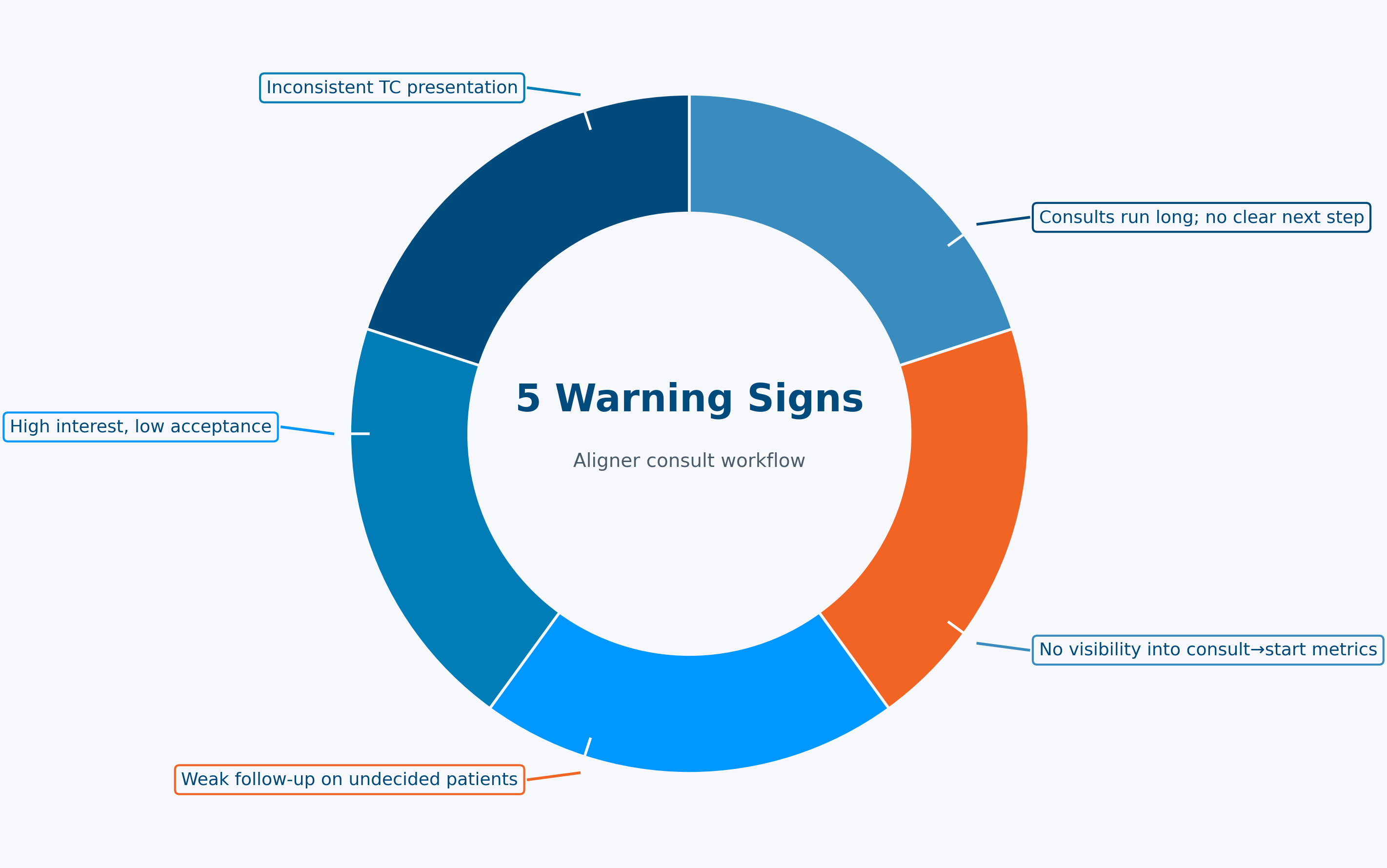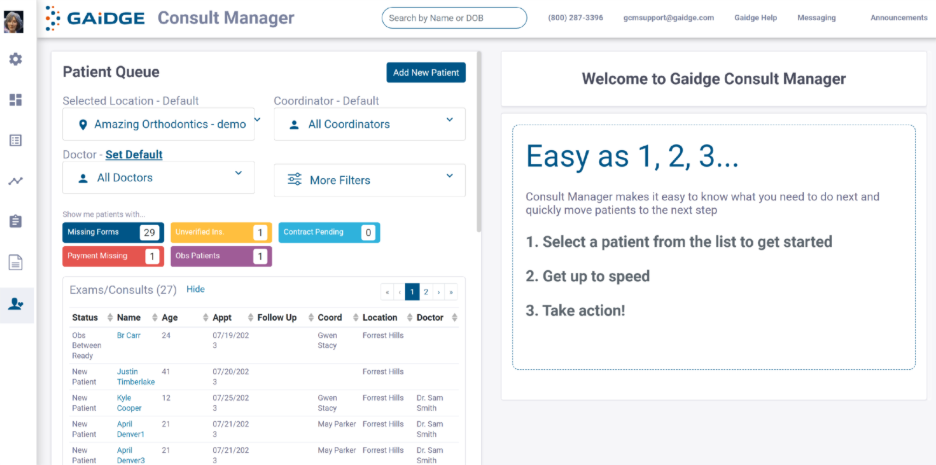5 Signs Your Dental Aligner Consult Workflow Is Costing You Patients

Key Takeaways
- Many practices convert ~50–60% of treatment plans, while top performers aim for ~75% case acceptance.
- Small workflow gaps (time overruns, uneven TC delivery, unclear fees, weak follow-up) erode confidence and starts.
- Gaidge Consult Manager centralizes consults, shows case acceptance/starts/pending, and structures follow-up.
- New Gaidge users reported a 12% increase in starts in year one on Gaidge, with stronger collections.
Aligner Consults: 5 Warning Signs Hurting Conversions (and How to Fix Them)
Most patients decide whether to begin aligner treatment during the consult. That makes your dental aligner consult workflow the single biggest factor in patient conversion. Yet, Gaidge data shows only about 65% of consults lead to treatment, leaving a third of potential case starts unrealized.
Why the shortfall? Small but costly breakdowns in the consult workflow can chip away at dental treatment acceptance and slow practice growth.
Below, we break down the warning signs in your aligner consult workflow and how to fix them before they cost you starts.

What Is a New Patient Consult for Aligners?
The new patient consult is where patients decide whether to trust your team and begin treatment. It sets the tone for the entire relationship and can either build momentum or bring it to a halt.
Patients respond best when the first visit gives them clarity: a clear explanation of treatment, an honest discussion of cost, and a confident handoff to the treatment coordinator. To the point, recent research on dental consultations shows that strong, patient-focused communication improves understanding and confidence, making patients more likely to accept treatment.
Get this stage right, and you lay the groundwork for stronger aligner patient conversion and lasting workflow efficiency.
5 Signs Your Aligner Consult Workflow Is Costing You Patients
Clear aligner consults may look organized on the surface but still break down in ways that cost you patients. From a visit that runs too long to not having the right data, all it takes is small gaps in the process for patients to slip away.
The five signs below highlight the most common breakdowns dental practices face during consults.
1. Consults Run Long Without a Clear Next Step
Symptom: Visits overrun, and patients leave with “I’ll think about it.”
Fix with Gaidge: Use Consult Manager's Patient Queue Dashboard to spot missing forms/insurance and keep the visit on time. Close with a same-day start or scheduled start before they stand up.
You’ll recognize this sign when consults run past the scheduled time and patients leave without having a financial conversation or accepting treatment. Instead of moving forward, they stall with “I’ll think about it,” and your practice loses treatment starts.
Most often, the slowdown begins in the new patient exam. A patient shows up without finishing forms, the front desk is still chasing insurance, or the appointment was never confirmed. Consequently, the exam runs long and patients are more likely to walk out undecided.
Gaidge Consult Manager’s Patient Queue Dashboard allows your team to spot gaps before the exam starts and resolve them early. That keeps the schedule on track and turns more consults into starts.
2. Inconsistent Treatment Coordinator Presentations
Symptom: mixed explanations, uneven confidence.
Fix with Gaidge: Standardize the flow and payment presentation so patients see scenarios and fees side-by-side every time.
Inconsistent treatment presentations are a clear sign of trouble. Dental plans often include add-ons and multiple scenarios, and without a consistent way to explain them, patients leave with mixed impressions and less confidence to commit.
With Gaidge Consult Manager, coordinators follow the same streamlined flow every time. Patients can compare scenarios and costs in one place, and TCs have a clear framework to present. The result is a consistent consult that builds trust and leads to more starts.
3. High Interest, Low Acceptance
Symptom: lots of nods, no scheduled starts.
Fix with Gaidge: Show fees, insurance, OOP, and adjust with the payment slider to land on a plan patients accept in-chair.
You know this problem when patients nod along, ask about timing or financing, and still walk out without scheduling. It’s not that patients aren’t interested. It’s that unclear payment makes them hesitate when they should be saying yes.
Gaidge Consult Manager makes the financial conversation simple. Patients see fees, insurance, and out-of-pocket costs in one clear summary, and the payment slider lets them adjust down payments and monthly amounts until they find a plan that fits. That way, instead of leaving uncertain, they make their decision in the chair.
4. Weak Follow-Up on Undecided Patients
Fix with Gaidge: Log every undecided patient and trigger reminders so TCs re-engage on schedule.
You’ll spot this sign when a patient leaves the consult undecided and there’s no follow-up. Without reminders, the TC moves on to the next case and those patients drift away. Gaidge Consult Manager keeps them on the radar and notifies the TC when to reach out, so more patients come back and start treatment.
5. No Visibility into Consult-to-Start Metrics
Fix with Gaidge: Track case acceptance by TC/doctor, starts, and pending, and know exactly where to coach and improve.
How many consults last month turned into treatment starts? If you can’t answer that, it’s a clear warning sign. The calendar may look full and your TC may be busy, but without consult-to-start data you don’t know where patients are falling out of the process.
Reporting in Gaidge Consult Manager gives you that visibility, showing case acceptance by TC or doctor and highlighting where patients stall. That way, you know exactly where to focus to increase starts.
How Gaidge Turns Consults into More Starts
It’s one thing to know consults aren’t converting the way they should. It’s another to see exactly where the process breaks down. Gaidge Consult Manager makes that possible by giving your team a structured, consistent way to run every consult and track what happens next.
With Consult Manager, you can:
- Run a consistent consult every time. Intake forms, contracts, and fees are presented in one system, so patients get the same clear explanation no matter who’s in the room.
- Track results in real time. Case acceptance, treatment starts, and pending patients are recorded automatically, giving you visibility into how consults are actually performing.
- Stay on top of follow-up. Every undecided patient is logged with notes and reminders, so you know exactly who still needs a call and when.
Structure is what turns consults from guesswork into data. When every consult runs the same way, you can see exactly where patients hesitate and address it.

Aligning Your Team to Improve Consult Outcomes
Strong consults don’t happen by chance. They come from a team that knows the numbers, follows a consistent process, and stays accountable week after week. Here are concrete ways to keep everyone aligned:
- Coach treatment coordinators with real cases. Review one consult per TC each week (shadow or recording). Score three items: clarity of plan, fee presentation, and the close. Role-play the weakest spot for five minutes. Track each TC’s close rate to build treatment coordinator efficiency.
- Standardize the consult flow. Time-box the visit (exam, doctor talk, TC). Decide exactly when fees are introduced and the words used for the doctor-to-TC handoff. Use a one-page checklist at chairside so every consult follows the same steps.
- Book the next step before the patient stands up. Offer two clear options: start today or schedule a start. If undecided, set a follow-up time on the spot and send a same-day recap with financing details.
- Set a follow-up cadence for undecided patients. Reach out at 24 hours, again at 7 days, and once more at 14 days. Log responses and track the pending list in your analytics so you can see improvement.
When training and structure are tied directly to the numbers, your team knows what’s expected and patients get a consult experience that consistently builds confidence to start.
Turning Data into Patient Growth
Consults will always be the make-or-break point for aligner case starts. The signs we covered show how easily patients can slip away through small breakdowns in time management, handoffs, or follow-up. The flip side is just as true: when you can see those breakdowns clearly, you can turn them into growth.
With Gaidge Consult Manager, practices get the visibility and structure to tighten consults and improve consistency.
Book a demo of Gaidge Consult Manager and learn how to turn consult bottlenecks into case starts.
Dental Aligner Conversion FAQs
How do you improve dental case acceptance?
Start by keeping the consult focused and easy to follow. Patients are more likely to say yes when the treatment, cost, and next steps are explained clearly and consistently.
Why do patients not start aligner treatment?
Hesitation usually comes from confusion about cost or value, or from leaving the consult without a clear next step. Lack of timely follow-up can also cause interest to fade.
How can dentists increase aligner conversions?
Create a standardized consult process, train your team to present treatment with confidence, and follow up promptly with patients who are undecided. These steps build trust and keep starts moving.
Updated September 26, 2025.
Lessons from Glander Rochford Orthodontics. (2025, February 12). Gaidge. https://www.gaidge.com/case-study/lessons-from-glander-rochford-orthodontics
Pilgrim, C., Catunda, R., Major, P., Arnaldo Perez-Garcia, & Flores-Mir, C. (2024). Patient-provider communication during consultations for elective dental procedures: A scoping review. American Journal of Orthodontics and Dentofacial Orthopedics. https://doi.org/10.1016/j.ajodo.2024.07.014
Reinhardt, S. (2025). 15 Patient Consultation Tips to Maximize Clear Aligner Success. The C.L.E.A.R. Institute. https://learn.theclearinstitute.com/blogs/news/15-patient-consultation-tips-to-maximize-clear-aligner-success?srsltid=AfmBOooK9hM4InMtb-Bgh7yHe6SUzfSlhja0w2d2FJU8_HGvYzjf46WE
Vinson, K. (2025, March 21). How to Maximize Case Acceptance & Improve Collections in Today’s Orthodontic Market. Gaidge. https://www.gaidge.com/blog/how-to-maximize-case-acceptance-improve-collections-in-todays-orthodontic-market




